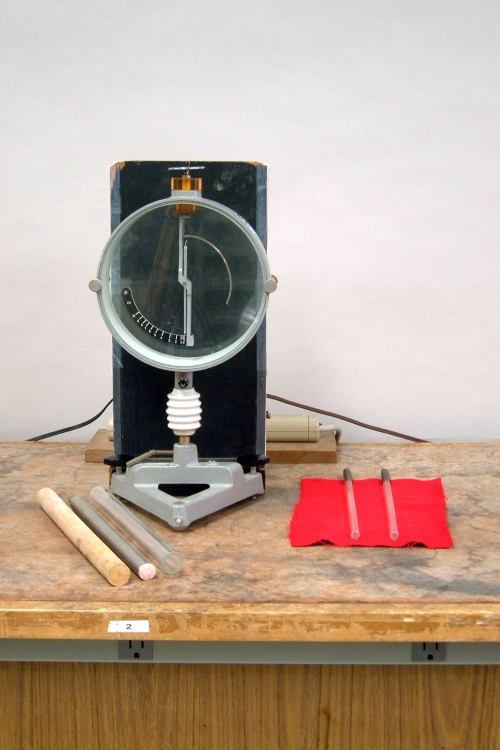
Charge the electroscope by using the plastic rod and red wool cloth. (This charges the top plate and needle assembly negative.) Touch the plate of the electroscope with the glass tube. The electroscope remains charged. Touch the top plate of the electroscope with the metal rod, and the electroscope discharges. If you charge the electroscope and then touch the top plate with the wooden rod, the electroscope discharges.
Materials are often broadly classified as conductors or insulators. For a substance to be a conductor, its electronic structure must be such that there are unoccupied energy levels close enough in energy to where the valence electrons normally reside that the electrons can easily be excited to those levels. In doing so, they leave vacancies (holes), which may then be filled by other electrons, thus allowing the electrons to move about the crystal lattice of the material, and a current to flow. These energy levels comprise what is commonly called the conduction band. The levels occupied by the unexcited valence electrons are known as the valence band. In an insulator, the conduction band lies at sufficiently high energy above the valence band that the valence electrons cannot easily reach the levels that lie there, and the material does not conduct electricity. This energy difference is called a band gap. In conductive materials, the band gap is small, and in insulators, the band gap is large. The number of valence electrons per atom (or molecule) also affects how good a conductor a material is.
As noted above, when you charge the electroscope and then touch the glass tube to the top plate, the electroscope remains charged. Glass is a very good insulator, and the excess electrons in the needle assembly and top plate cannot flow through the glass tube to your hand. The steel rod, however, is a good conductor, so that when you then touch the top plate with it, the excess electrons in the needle assembly and top plate flow through the rod into your hand, and you discharge the electroscope. (You may notice a small arc between the top plate and the steel rod as the rod gets close to the plate.)
We normally think of wood as an insulator, and in most ordinary situations it does not conduct electricity. When you charge the electroscope and then touch the top plate with the wood dowel, however, you discharge the electroscope.
The capacitance of the electroscope is quite small (~29 pF), so when you charge the mechanism with the plastic rod, the potential difference across the electroscope reaches several kilovolts. (See demonstration 56.12 – Electroscope.) Given the small capacitance of the electroscope, it takes only a small current to discharge it. As high as the resistance of the wood dowel is, the potential of several kilovolts on the top plate with respect to your hand, which is essentially at ground potential, is great enough to produce such a current. When you touch the top plate of the charged electroscope with the wood dowel, then, it discharges.